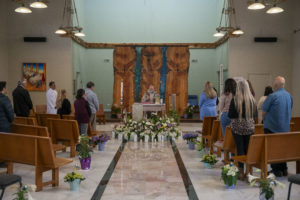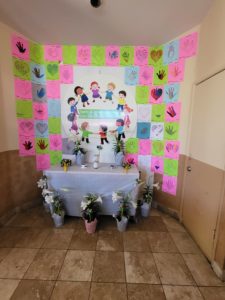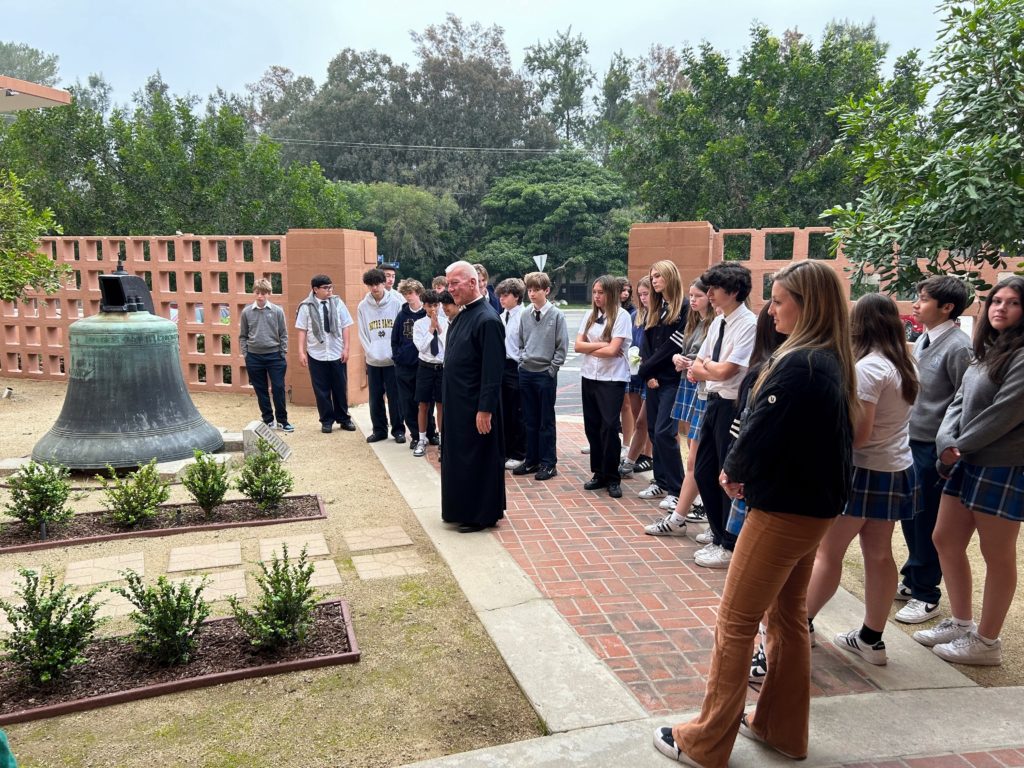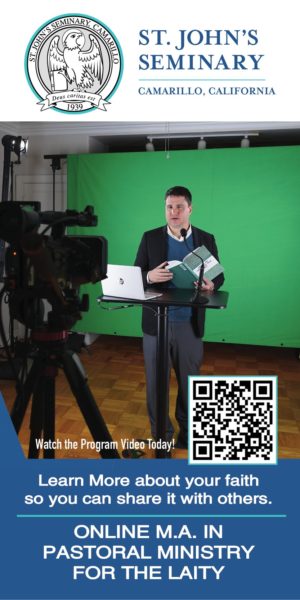Addressing students during the school’s morning Mass on April 12, Father Michael Wakefield, pastor at St. Francis de Sales Church in Sherman Oaks, relayed a story about a woman who inquired about the healing garden along the parish’s outside wall.
“Is this only for those who were abused as children?” she asked.
“No, not at all,” Wakefield said.
“Good,” she said.
“She sat on one of the benches outside and sobbed the entire time,” recalled the priest.
For Wakefield, stories like these help illustrate the deeper meaning of the events and activities organized around the Archdiocese of Los Angeles as part of National Child Abuse Prevention Month, marked every April.
In coordination with the archdiocese’s Office of Safeguard the Children — celebrating its 20th anniversary this year — parishes hosted events like St. Francis of Sales’ throughout April to promote awareness and demonstrate closeness to victim-survivors of abuse. Among them was a special April 15 Mass dedicated to survivors of sexual abuse at the St. Camillus Center for Spiritual Care in East Los Angeles, the site of the first healing garden.
Their ultimate goal, organizers said, is a change of culture when it comes to protecting the most vulnerable among us.

“This sexual abuse prevention programming that we do with kids is every bit as important as looking both ways before you cross the street or putting your seatbelt on when you get in the car,” said Heather Banis, Ph.D., victims assistance coordinator with the archdiocese’s Office of Victims Assistance Ministry. “Because these are safety measures.
“We’ve been at it for 20-plus years. The focus on prevention is huge and by our data, our audit report, I think it’s clear that a huge impact is happening.”
Part of the change, Banis said, also comes from repairing the damage done from the past and working to change the institution that allowed the wounds in the first place.
“First and foremost, we have a responsibility,” she said. “I think if we are calling ourselves Christians and Catholics, we have to acknowledge that and step up, take responsibility for what we did and didn’t do and then take active meaningful steps to fix that, to change that.”
For the past 20 years, more than 440,000 priests, educators, volunteers, and laypeople in the archdiocese have been trained in VIRTUS, a national program designed to help prevent child sexual abuse. More than 355,000 children and young people have participated in the “Empowering God’s Children and Young People Safety Program” to equip them with the tools to stay safe from potential harm.
Coupled with mandatory fingerprinting, the “Working Together to Prevent Child Sexual Abuse” brochure and consistent messaging both online and in parishes and schools, the archdiocese sees that the effort is paying off.
“It’s clear kids are feeling empowered to say, ‘I don’t want this touch’ or, ‘I didn’t like that touch,’ ” Banis said. “Or ‘I know if I get pressed and I’m uncomfortable, I can ask people about it because they’re prepared to talk to me about it.’
“It’s all about changing the culture for the kids to have that expectation of being believed, being heard, and being supported.”
Just as Wakefield took pride in his parish’s healing garden, one of the next accomplishments will be installing the final landscape in fulfilling the goal of having a garden in each of the archdiocese’s five regions. The fifth healing garden will be located in the San Pedro Pastoral Region and is expected to be completed by Nov. 18, the United Nations’ World Day for the Prevention of and Healing from Child Sexual Exploitation, Abuse and Violence.
“The gardens are the next layer in this, where there is that sense of permanence and acknowledgement, which is not something we’re trying to get over and move on from,” Banis said. “This is a sad, tragic part of our history but it is part of our history. From what survivors say to me, to see that kind of permanence is really impactful for them because they feel so invisible.”

Back at St. Francis de Sales’ Mass, students — clad in their blue, white, and gray uniforms — asked for special intentions: “May all who work with children and young people be vigilant in protecting them from harm.”
After the Mass, Wakefield took waves of students outside to the garden to explain its purpose and allow the children to place flowers or intentions and pray for those affected.
“Does this make up for it? No, it doesn’t,” Wakefield said. “That innocence has been taken away. But what we can do is provide some means of reaching out to people and trying to be a conduit of God’s goodness and God’s healing.”
Later, Wakefield was asked what prompted him to bring the healing garden to his parish.
“This is now what we do because we think our children are so important and our children are so precious to us,” he said. “It’s the least we can do to try to make up for the damage that was done.”
You can learn more about the Archdiocese of LA’s abuse prevention efforts at lacatholics.org/protect.

